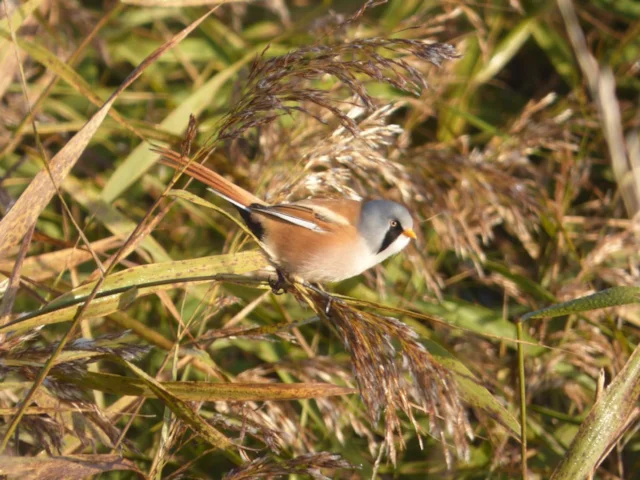Bearded Tit hits record numbers in Britain
333e816c-b272-42f3-96a8-eb99eb8f5541

Bearded Tit has continued to bounce back from a population crash to reach its highest numbers ever in Britain, according to the latest survey.
The Rare Breeding Birds in the UK report, published by the Rare Breeding Birds Panel, revealed that the Bearded Tit population has increased from 618 pairs in 2013 to 772 pairs in 2014 – the highest number since monitoring of the species began in 1995.
The record population is made even more remarkable by the population crash that occurred in 2011. Bearded Tits are very sensitive to cold hard winters and this can have a knock-on effect on their breeding success – the 2011 survey revealed the population had declined by nearly half to only 360 pairs after a disastrously cold December the previous year. This is the third year in a row that numbers have increased, and it is hoped that the work to improve and create more habitat for it across RSPB nature reserves will allow Bearded Tit numbers to continue to grow into a more stable population.
Dr Mark Eaton, RSPB Conservation Scientist and Chairman of the Rare Breeding Bird Panel, said: “It is always special to see Bearded Tits dancing and diving about the reedbeds on a crisp winter’s morning – such a charismatic bird.
“Unfortunately they are very sensitive to hard winter weather and there was a big dip in numbers after a particular harsh winter in 2010. But when they have a good breeding season, like in recent years, they can produce lots of young so numbers can bounce back rapidly. As the population can fluctuate year on year it’s vital that we continue to manage the reedbeds they call home to give them the best chance of thriving.”
Named after the dark facial markings on the males that resemble a moustache, Bearded Tits live in well-managed reedbeds. The historic loss of this wetland habitat across Britain has resulted in the population becoming fragmented across isolated areas in the South-West, eastern and northern parts of England.
The Humber, a large tidal estuary on the east coast of Northern England, is one area that has become a stronghold for Bearded Tit in Britain. Work to create new ponds and extra management of reedbeds has resulted in the population recovering, with good numbers at Blacktoft Sands RSPB helping to take the population on the Humber from around 40 to 250 pairs in just five years.
The Rare Breeding Birds in the UK report, published by the Rare Breeding Birds Panel, revealed that the Bearded Tit population has increased from 618 pairs in 2013 to 772 pairs in 2014 – the highest number since monitoring of the species began in 1995.
The record population is made even more remarkable by the population crash that occurred in 2011. Bearded Tits are very sensitive to cold hard winters and this can have a knock-on effect on their breeding success – the 2011 survey revealed the population had declined by nearly half to only 360 pairs after a disastrously cold December the previous year. This is the third year in a row that numbers have increased, and it is hoped that the work to improve and create more habitat for it across RSPB nature reserves will allow Bearded Tit numbers to continue to grow into a more stable population.
Dr Mark Eaton, RSPB Conservation Scientist and Chairman of the Rare Breeding Bird Panel, said: “It is always special to see Bearded Tits dancing and diving about the reedbeds on a crisp winter’s morning – such a charismatic bird.
“Unfortunately they are very sensitive to hard winter weather and there was a big dip in numbers after a particular harsh winter in 2010. But when they have a good breeding season, like in recent years, they can produce lots of young so numbers can bounce back rapidly. As the population can fluctuate year on year it’s vital that we continue to manage the reedbeds they call home to give them the best chance of thriving.”
Named after the dark facial markings on the males that resemble a moustache, Bearded Tits live in well-managed reedbeds. The historic loss of this wetland habitat across Britain has resulted in the population becoming fragmented across isolated areas in the South-West, eastern and northern parts of England.
The Humber, a large tidal estuary on the east coast of Northern England, is one area that has become a stronghold for Bearded Tit in Britain. Work to create new ponds and extra management of reedbeds has resulted in the population recovering, with good numbers at Blacktoft Sands RSPB helping to take the population on the Humber from around 40 to 250 pairs in just five years.

